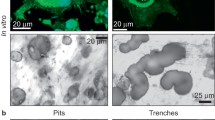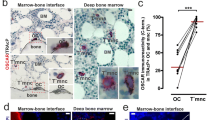Abstract
Chemokines are important mediators of chemotaxis, cell adherence, and proliferation and exert specific functions in bone remodeling. Despite the potential intriguing role of chemokines in the regulation of osteoclast (OC) functions, little is known about the expression of chemokines and their receptors in human OCs at different stages of differentiation. Therefore, we analyzed the expression of CXC chemokine receptors (CXCR1, CXCR2, CXCR3, CXCR4 and CXCR5) and ligands (CXCL8, CXCL10, CXCL12 and CXCL13) both at molecular and protein levels, in human OCs grown on plastic or calcium phosphate-coated slides at different stages of differentiation. Real-time PCR showed that CXCR1, CXCR2, CXCR3, CXCR4, CXCR5 and CXCL8 were expressed in undifferentiated cells and significantly decreased during OC differentiation. By contrast, CXCL10 and CXCL12 were strongly upregulated from day 0 to day 8 in cells grown on calcium phosphate-coated slides. Immunocytochemistry showed that OCs grown on plastic expressed CXCR3, CXCR4, CXCR5, CXCL8 and CXCL12, while they were negative for CXCR1, CXCR2 and CXCL10. Interestingly, both at molecular and protein levels CXCL10 and CXCL12 significantly increased only when cells were differentiated on calcium phosphate-coated slides. These data suggest that the selection of a substrate that better mimics the tridimensional structure of bone tissue, thus favoring OC maturation and differentiation, may be necessary when studying osteoclastogenesis in vitro.






Similar content being viewed by others
References
Aiuti A, Turchetto L, Cota M, Cipponi A, Brambilla A, Arcelloni C, Paroni R, Vicenzi Bordigon C, Poli G (1999) Human CD34(+) cells express CXCR4 and its ligand stromal cell-derived factor-1. Implications for infection by T-cell tropic human immunodeficiency virus. Blood 94:62–73
Baggiolini M (2001) Chemokines in pathology and medicine. J Intern Med 250:91–104
Belperio JA, Keane MP, Arenberg DA, Addison CL, Ehlert JE, Burdick MD, Strieter RM (2000) CXC chemokines in angiogenesis. J Leukoc Biol 68:1–8
Blanco FJ, Geng Y, Lotz M (1995) Differentiation-dependent effects of IL-1 and TGF-beta on human articular chondrocyte proliferation are related to inducible nitric oxide synthase expression. J Immunol 154:4018–4026
Delima AJ, Karatzas S, Amar S, Graves DT (2002) Inflammation and tissue loss caused by periodontal pathogens is reduced by interleukin-1 antagonists. J Infect Dis 186:511–516
Ducy P, Schinke T, Karsenty G (2000) The osteoblast: a sophisticated fibroblast under central surveillance. Science 289:1501–1504
Fuller K, Chambers TJ (1989) Bone matrix stimulates osteoclastic differentiation in cultures of rabbit bone marrow cells. J Bone Miner Res 4:179–183
Fuller K, Lean JM, Bayley KE, Wani MR, Chambers TJ (2000) A role for TGF-β1, in osteoclast differentiation and survival. J Cell Sci 113:2445–2453
Grassi F, Cristino S, Toneguzzi S, Piancentini A, Facchini A, Lisignoli G (2003) CXCL12 chemokine up-regulates bone resorption and MMP-9 release by human osteoclasts: CXCL12 levels are increased in synovial and bone tissue of rheumatoid arthritis patients. J Cell Physiol (in press)
Graves DT, Alsulaimani F, Ding Y, Marks SC Jr (2002) Developmentally regulated monocyte recruitment and bone resorption are modulated by functional deletion of the monocytic chemoattractant protein-1 gene. Bone 31:282–287
Han J-H, Chol SJ, Kurihara N, Koide M, Oba Y, Roodman GD (2001) Macrophage inflammatory protein-1α is an osteoclastogenic factor in myeloma that is independent of receptor activity of nuclear factor kB ligand. Blood 97:3349–3353
Hentunen TA, Cunningham NS, Vuolteenaho O, Reddi AH, Väänänen HK (1994) Osteoclast recruiting activity in bone matrix. Bone Miner 25:183–198
Heymann D, Guicheux J, Rousselle AV (2001) Ultrastructural evidence in vitro of osteoclast-induced degradation of calcium phosphate ceramic by simultaneous resorption and phagocytosis mechanisms. Histol Histopathol 16:37–44
Lean JM, Murphy C, Fuller K, Chambers TJ (2002) CCL9/MIP-1 γ and its receptor CCR1 are the major chemokine ligand/receptor species expressed by osteoclasts. J Cell Biochem 87:386–393
Leeuwenburgh S, Layrolle P, Barrere F, de Bruijn J, Schoonman J, van Blitterswijk CA, de Groot K (2001) Osteoclastic resorption of biomimetic calcium phosphate coatings in vitro. J Biomed Mater Res 56:208–215
Lisignoli G, Toneguzzi S, Pozzi C, Piacentini A, Riccio M, Ferruzzi A, Gualtieri G, Facchini A (1999) Proinflammatory cytokines and chemokine production and expression by human osteoblasts isolated from patients with rheumatoid arthritis and osteoarthritis. J Rheumatol 26:791–799
Lisignoli G, Piacentini A, Toneguzzi S, Grassi F, Cocchini B, Ferruzzi A, Gualtieri G, Facchini A (2000) Osteoblasts and stromal cells isolated from femora in rheumatoid arthritis (RA) and osteoarthritis (OA) patients express IL-11, leukaemia inhibitory factor and oncostatin M. Clin Exp Immunol 119:346–353
Lisignoli G, Toneguzzi S, Grassi F, Piacentini A, Tschon M, Cristino S, Gualtieri G, Facchini A (2002) Different chemokines are expressed in human arthritic bone biopsies: IFN-gamma and IL-6 differently modulate IL-8, MCP-1 and RANTES production by arthritic osteoblasts. Cytokine 20:213–238
Lisignoli G, Toneguzzi S, Piacentini A, Cattini L, Lenti A, Tschon M, Cristino S, Grassi F, Facchini A (2003a) Human osteoblasts express functional CXC chemokine receptors 3 and 5: activation by their ligands, CXCL10 and CXCL13, significantly induces alkaline phosphatase and beta N-acetylhexosaminidase release. J Cell Physiol 194:71–79
Lisignoli G, Toneguzzi S, Piacentini A, Cristino S, Cattini L, Grassi F, Facchini A (2003b) Recruitment and proliferation of T lymphocytes is supported by IFNγ- and TNFα-activated human osteoblasts: involvement of CD54 (ICAM-1) and CD106 (VCAM-1) adhesion molecules and CXCR3 chemokine receptor. J Cell Physiol (in press)
Mackay CR (2001) Chemokines: immunology’s high impact factors. Nat Immunol 2:95–101
Monchau F, Lefevre A, Descamps M, Belquin-Myrdycz A, Laffargue P, Hildebrand HF (2002) In vitro studies of human and rat osteoclast activity on hydroxyapatite, beta-tricalcium phosphate, calcium carbonate. Biomol Eng 19:143–152
Nielsen H, Petersen AA, Skjodt H, Horslev-Petersen K, Bendtzen K (1999) Blood levels of CD11b+ memory T lymphocytes are selectively upregulated in patients with active rheumatoid arthritis. APMIS 107:1124–1130
Rozen S, Skaletsky HJ (2000) Primer3 on the WWW for general users and for biologist programmers. In: Krawetz S, Misener S (eds) Bioinformatics methods and protocols: methods in molecular biology. Humana, Totowa, NJ, pp 365–386
Sauty A, Colvin RA, Wagner L, Rochat S, Spertini F, Luster AD (2001) CXCR3 internalization following T cell–endothelial cell contact: preferential role of IFN-inducible T cell α chemoattractant (CXCL11). J Immunol 167:7084–7093
Scheven BAA, Milne JS, Hunter I, Robins SP (1999) Macrophage-inflammatory protein-1α regulates preosteoclast differentiation in vitro. Biochem Biophys Res Commun 254:773–778
Takahashi N, Udagawa N, Takami M, Suda T (2002) Cells of bone. Osteoclast generation. In: Bilezikian JP, Raisz LG, Rodan GA (eds) Principles of bone biology, vol 1. Academic, San Diego, pp 109–126
Teitelbaum SL (2000) Bone resorption by osteoclasts. Science 289:1504–1508
Väänänen K, Zhao H (2002) Osteoclast function. Biology and mechanisms. In: Bilezikian JP, Raisz LG, Rodan GA (eds) Principles of bone biology, vol 1. Academic, San Diego, pp 127–139
Volejnikova S, Marks SCJr, Graves DT (2002) Tumor necrosis factor modulates apoptosis of monocytes in areas of developmentally regulated bone remodeling. J Bone Miner Res 17:991–997
Yu X, Huang Y, Collin-Osdoby P, Osdoby P (2003) Stromal cell-derived factor-1 (SDF-1) recruits osteoclast precursors by inducing chemotaxis, matrix metalloproteinase-9 (MMP-9) activity, and collagen transmigration. J Bone Miner Res 18:1404–1418
Zlotnik A, Yoshie O (2001) Chemokines: a new classification system and their role in immunity. Immunity 12:121–127
Acknowledgements
This work was partially supported by grants from Istituti Ortopedici Rizzoli, Bologna, Italy, and MIUR, Università degli Studi di Bologna, Italy. The authors wish to thank Mrs. Patrizia Rappini and Graziella Salmi for the assistance in the preparation of the manuscript, Mr. Keith Smith for editing, and Mr. Luciano Pizzi for technical assistance.
Author information
Authors and Affiliations
Corresponding author
Rights and permissions
About this article
Cite this article
Grassi, F., Piacentini, A., Cristino, S. et al. Human osteoclasts express different CXC chemokines depending on cell culture substrate: molecular and immunocytochemical evidence of high levels of CXCL10 and CXCL12. Histochem Cell Biol 120, 391–400 (2003). https://doi.org/10.1007/s00418-003-0587-3
Accepted:
Published:
Issue Date:
DOI: https://doi.org/10.1007/s00418-003-0587-3




